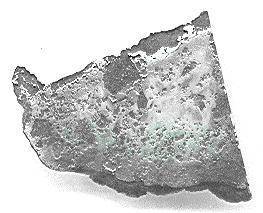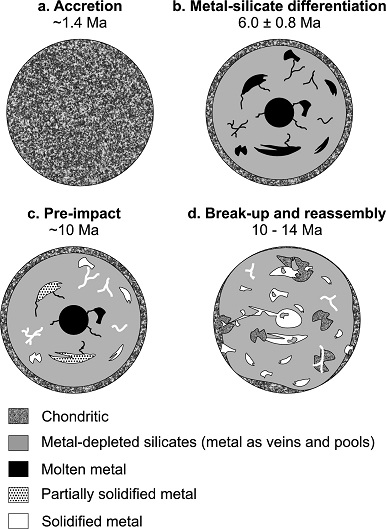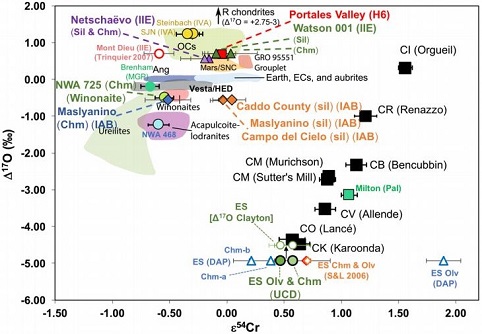Iron, IAB complex, Udei Station grouplet

Fell spring 1927
7° 57′ N., 8° 5′ E. A 103 kg mass was seen and heard to fallMeteorite seen to fall. Such meteorites are usually collected soon after falling and are not affected by terrestrial weathering (Weathering = 0). Beginning in 2014 (date needs confirmation), the NomComm adopted the use of the terms "probable fall" and "confirmed fall" to provide better insight into the meteorite's history. If Click on Term to Read More in the daytime near the Benue River in Nigeria. The Geological Survey of Nigeria learned of the event in 1935 when the mass was recovered from a shallow hole six miles west of the railway station at Udei and 23 miles north of Makurdi. Some reports state that a second mass exists.
The IAB iron-meteorite complex, recently proposed by Wasson and Kallemeyn (2002), comprises iron meteorites from the former IAB-IIICD group, as well as numerous related irons. Many of the members contain
silicateThe most abundant group of minerals in Earth's crust, the structure of silicates are dominated by the silica tetrahedron, SiO44-, with metal ions occurring between tetrahedra). The mesodesmic bonds of the silicon tetrahedron allow extensive polymerization and silicates are classified according to the amount of linking that occurs between the inclusions with roughly chondritic compositions. Udei Station is a low-Au member of the IAB complex that is closely related to the main group. On a Ni–
AuThe astronomical unit for length is described as the "mean" distance (average of aphelion and perihelion distances) between the Earth and the Sun. Though most references state the value for 1 AU to be approximately 150 million kilometers, the currently accepted precise value for the AU is 149,597,870.66 km. The Click on Term to Read More diagram, a grouplet of six members has been resolved in an area close to the sLL subgroup, but with anomalous Ni contents; these meteorites were designated the Udei Station grouplet. Although theories of formation for these irons commonly attribute their origin to impact-melt pools, correlations between Ni abundance and several chemical and physical properties alternatively suggest an interaction with a crystallizing metallic
coreIn the context of planetary formation, the core is the central region of a large differentiated asteroid, planet or moon and made up of denser materials than the surrounding mantle and crust. For example, the cores of the Earth, the terrestrial planets and differentiated asteroids are rich in metallic iron-nickel. Click on Term to Read More. The absolute I–Xe retention age, relative to the Shallowater standard, was calculated to be ~4.558 b.y., while the
metamorphicRocks that have recrystallized in a solid state due to changes in temperature, pressure, and chemical environment. Click on Term to Read More resetting of the K–Ar chronometer occurred ~4.31 b.y. ago (Bogard
et al, 2005; Pravdivtseva
et al, 2013).
Udei Station is a medium
octahedriteMost Common type of iron meteorite, composed mainly of taenite and kamacite and named for the octahedral (eight-sided) shape of the kamacite crystals. When sliced, polished and etched with an acid such as nitric acid, they display a characteristic Widmanstätten pattern. Spaces between larger kamacite and taenite plates are often Click on Term to Read More that contains a high proportion of silicates and
troiliteBrass colored non-magnetic mineral of iron sulfide, FeS, found in a variety of meteorites. Click on Term to Read More. Silicate inclusions range in size from single grains to as large as 8 cm, and they are composed of
enstatiteA mineral that is composed of Mg-rich pyroxene, MgSiO3. It is the magnesium endmember of the pyroxene silicate mineral series - enstatite (MgSiO3) to ferrosilite (FeSiO3). Click on Term to Read More,
olivineGroup of silicate minerals, (Mg,Fe)2SiO4, with the compositional endpoints of forsterite (Mg2SiO4) and fayalite (Fe2SiO4). Olivine is commonly found in all chondrites within both the matrix and chondrules, achondrites including most primitive achondrites and some evolved achondrites, in pallasites as large yellow-green crystals (brown when terrestrialized), in the silicate portion Click on Term to Read More, oligoclase, and diopside representing various subchondritic rock types including basalt–
gabbroWork in progress Coarse-grained igneous rock of basaltic composition that formed at depth and is 90% plagioclase. clinopyroxene, https://www.sandatlas.org/gabbro/ The most important mineral groups that make up this rock type are plagioclase and pyroxene. Plagioclase usually predominates over pyroxene. Plagioclase is sodium-calcium feldspar. It contains more calcium than sodium in gabbro. If there is Click on Term to Read More, feldspathic
orthopyroxeniteA rock composed primarily of orthopyroxene. Non-terrestrial orthopyoxenites include diogenites and a single martian meteorite, ALH 84001, that was found in the Allan Hills region of Antarctica in 1984. ALH 84001 is a cumulate rock consisting of 97% coarse-grained, Mg-rich orthopyroxene, with small amounts of plagioclase, chromite, and carbonate. It Click on Term to Read More, lherzolite, and harzburgite. Some of the inclusions crystallized from a low degree partial melt (~3–10%) reaching a peak temperature of <1180°C, while others represent a partial melt residue (Ruzicka and Hutson, 2009). Identification of an FeO-poor, Na-rich gabbroic
inclusionFragment of foreign (xeno-) material enclosed within the primary matrix of a rock or meteorite. Click on Term to Read More similar to one found in Caddo County is only the second discovery of such material. It was concluded that
interstitialTerm applied to ions or atoms occupying sites between lattice points. Click on Term to Read More silicate melt migration and removal occurred, assisted by CO gas (now manifest as
graphiteOpaque form of carbon (C) found in some iron and ordinary chondrites and in ureilite meteorites. Each C atom is bonded to three others in a plane composed of fused hexagonal rings, just like those in aromatic hydrocarbons. The two known forms of graphite, α (hexagonal) and β (rhombohedral), have Click on Term to Read More), while low abundances of metallic melt (~37%) became trapped in veins between solid silicate assemblages (Ruzicka and Hutson, 2009). One plausible model involves impact processing within small melt pools that led to
brecciationThe formation of a breccia through a process by which rock fragments of of various types are recemented or fused together. Click on Term to Read More and mixing of rock clasts from different locations having different thermal histories (ranging from igneous to chondritic) with metallic melt. These melt pools were then slowly cooled, consistent with burial within a deep
regolithMixture of unconsolidated rocky fragments, soil, dust and other fine granular particles blanketing the surface of a body lacking an atmosphere. Regolith is the product of "gardening" by repeated meteorite impacts, and thermal processes (such as repeated heating and cooling cycles). Click on Term to Read More.
A formation model that accounts for such a wide variety of inclusions and disparate petrographic evidence was proposed by Ruzicka and Hutson (2009) and Ruzicka (2014). They conceive of a major collisional disruption/jumbling of a partially molten, incompletely differentiated planetesimal. They consider winonaites to be derived from the outer layers of this body. At the same time, they envision the IAB complex irons that were more rapidly cooled, exhibit older I–Xe ages, and which are Ni-rich, to have derived from the middle layers, while those that were more slowly cooled, exhibit younger I–Xe ages, and which are Ni-poor, to have derived from the lowest layers. This was a severe impact that mixed material from different depths on the parent body—solid subchondritic material from the cooler regions, and fractionated material from very hot regions—causing metallic melt to be injected into the silicates.
Utilizing the short-lived
182Hf–
182W chronometer, corrected for
neutronCharge-neutral hadron with a mass of 1.6748 x 10-27 kg, equivalent to 939.573 MeV, and an intrinsic angular momentum, or spin, of ½ (in units of h/2π). The neutron is a nucleon, one of the two basic constituents of all atomic nuclei (apart from 1H, which consists of a single Click on Term to Read More capture by
182W due to galactic
cosmic raysHigh-energy subatomic particles mainly originating outside the Solar System that continuously bombard the Earth from all directions. They represent one of the few direct samples of matter from outside our solar system and travel through space at nearly the speed of light. These charged particles – positively charged protons or Click on Term to Read More, Hunt
et al. (2018) derived the timing of metal–silicate separation of all genetically-related IAB irons (at least the MG and sLL subgroup [possibly also the sLM subgroup] and the
ungroupedModifying term used to describe meteorites that are mineralogically and/or chemically unique and defy classification into the group or sub-group they most closely resemble. Some examples include Ungrouped Achondrite (achondrite-ung), Ungrouped Chondrite (chondrite-ung), Ungrouped Iron (iron-ung), and Ungrouped Carbonaceous (C-ung). Click on Term to Read More Caddo County [Udei Station grouplet] and Livingstone [Algarrabo duo]) to 6.0 (±0.8) m.y. after
CAIsSub-millimeter to centimeter-sized amorphous objects found typically in carbonaceous chondrites and ranging in color from white to greyish white and even light pink. CAIs have occasionally been found in ordinary chondrites, such as the L3.00 chondrite, NWA 8276 (Sara Russell, 2016). CAIs are also known as refractory inclusions since they Click on Term to Read More. Based on the constraints provided by the timing of
metalElement that readily forms cations and has metallic bonds; sometimes said to be similar to a cation in a cloud of electrons. The metals are one of the three groups of elements as distinguished by their ionization and bonding properties, along with the metalloids and nonmetals. A diagonal line drawn Click on Term to Read More segregation, they modeled the early history of the 120(+)-km-diameter IAB
parent bodyThe body from which a meteorite or meteoroid was derived prior to its ejection. Some parent bodies were destroyed early in the formation of our Solar System, while others like the asteroid 4-Vesta and Mars are still observable today. Click on Term to Read More as outlined in the following diagram:

Diagram credit: Hunt
et al.,
EPSL, vol. 482, pp. 497 (2018,
open access link)
‘Late metal–silicate separation on the IAB parent asteroid: Constraints from combined W and Pt isotopes and thermal modelling’
(https://doi.org/10.1016/j.epsl.2017.11.034)’ Dey
et al. (2019) employed
17O and ε
54Cr values for several irons and their associated silicates/oxides to investigate i) if each iron and its associated phases originated on a common parent body (
i.e., an endogenous mixture of core and
mantleMain silicate-rich zone within a planet between the crust and metallic core. The mantle accounts for 82% of Earth's volume and is composed of silicate minerals rich in Mg. The temperature of the mantle can be as high as 3,700 °C. Heat generated in the core causes convection currents in Click on Term to Read More vs. an exogenous mixture through impact), and ii) if any genetic connection exists between the irons and other
meteoriteWork in progress. A solid natural object reaching a planet’s surface from interplanetary space. Solid portion of a meteoroid that survives its fall to Earth, or some other body. Meteorites are classified as stony meteorites, iron meteorites, and stony-iron meteorites. These groups are further divided according to their mineralogy and Click on Term to Read More groups (
e.g., IAB with winonaites, IIE with H
chondritesChondrites are the most common meteorites accounting for ~84% of falls. Chondrites are comprised mostly of Fe- and Mg-bearing silicate minerals (found in both chondrules and fine grained matrix), reduced Fe/Ni metal (found in various states like large blebs, small grains and/or even chondrule rims), and various refractory inclusions (such Click on Term to Read More, and Eagle Station pallasites with CK chondrites). Three IAB irons were employed in the study, and it was demonstrated on a coupled diagram that although the ε
54Cr values for the iron component plot in the
winonaitea partially differentiated asteroid that was disrupted just as it began to form an Fe core and a silicate-rich crust. This disrupting impact mixed silicates into molten Ni-Fe metal forming the silicated IAB irons, and mixed olivine-rich residues of partial melts into unmelted silicates, forming the winonaites. A few winonaites Click on Term to Read More field, values for the silicate component plot in a distinct region on an O–Cr coupled diagram (see diagram below). From these results they ascertained that the the IAB silicated irons formed through an impact-generated mixture comprising iron from a winonaite-related parent body and silicate from an unrelated and otherwise unsampled parent body. Incorporation of the silicates into the FeNi-metal host took place at a depth greater than 2 km, allowing time for a Thomson (Widmanstätten) structure to develop during a long cooling phase.
Fractional crystallizationA crystallization process in which minerals crystallizing from a magma are isolated from contact with the liquid. It is a key process in the formation of igneous rocks during the process of magmatic differentiation. Also known as crystal fractionation. Click on Term to Read More occurred in some large molten metal pools, followed by very slow cooling, to produce the broad range of features found in certain IAB meteorites (
e.g., silicate-poor, graphite–troilite-rich inclusions and extremely high Ni contents). Other results from their study can be found on the
Miles and
Eagle Station pages.
17O
vs. ε
54Cr for Irons and Pallasites
 click on photo for a magnified view
click on photo for a magnified view
Diagrams credit: Dey
et al., 50th LPSC,
#2977 (2019)
Udei Station has a Cl–Ar-based CRE age of 123 m.y. (Albrecht
et al., 2000). It plots as an anomalous member of group IAB in several regards. It contains a
clastA mineral or rock fragment embedded in another rock. Click on Term to Read More best described as a peridotite, composed of the most Fe-rich
maficOne of the two broad categories of silicate minerals, the other being felsic, based on its magnesium (Mg) and/or iron (Fe) content. Mafic indicates silicate minerals that are predominantly comprised of Mg and/or Fe.The term is derived from those major constituents: Magnesium + Ferrum (Latin for iron) + ic (having Click on Term to Read More minerals found among IAB irons. Some variability in appearance is apparent in some members of this grouplet, as can be seen in the
Four Corners meteorite. The specimen shown above is a 26.3 g partial slice exhibiting a high content of silicates.









